The Intel 6th Gen Skylake Review: Core i7-6700K and i5-6600K Tested
by Ian Cutress on August 5, 2015 8:00 AM ESTGenerational Tests on the i7-6700K: Legacy, Office and Web Benchmarks
Moving on to the generational tests, and similar to our last Broadwell review I want to dedicate a few pages to specifically looking at how stock speed processors perform as Intel has released each generation. For this each CPU is left at stock, DRAM set to DDR3-1600 (or DDR4-2133 for Skylake in DDR4 mode) and we run the full line of CPU tests at our disposal.
Legacy
Some users will notice that in our benchmark database Bench, we keep data on the CPUs we’ve tested back over a decade and the benchmarks we were running back then. For a few of these benchmarks, such as Cinebench R10, we do actually run these on the new CPUs as well, although for the sake of brevity and relevance we tend not to put this data in the review. Well here are a few of those numbers too.

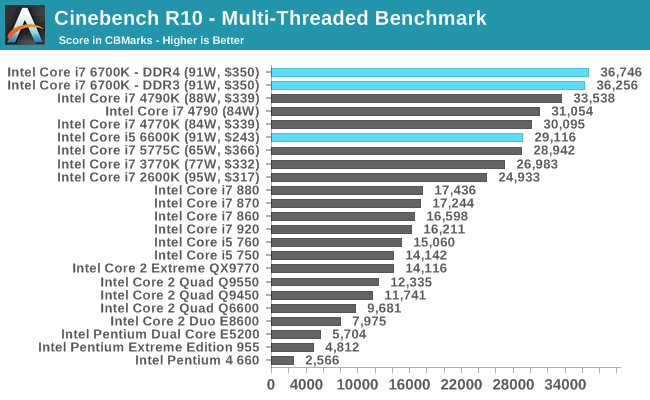


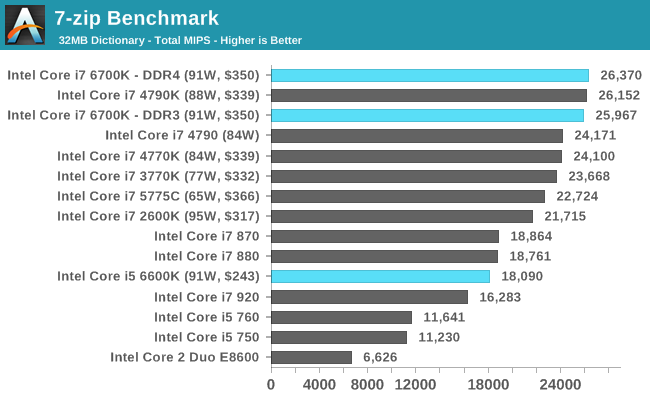
Even with the older tests that might not include any new instruction sets, the Skylake CPUs sit on top of the stack.
Office Performance
The dynamics of CPU Turbo modes, both Intel and AMD, can cause concern during environments with a variable threaded workload. There is also an added issue of the motherboard remaining consistent, depending on how the motherboard manufacturer wants to add in their own boosting technologies over the ones that Intel would prefer they used. In order to remain consistent, we implement an OS-level unique high performance mode on all the CPUs we test which should override any motherboard manufacturer performance mode.
Dolphin Benchmark: link
Many emulators are often bound by single thread CPU performance, and general reports tended to suggest that Haswell provided a significant boost to emulator performance. This benchmark runs a Wii program that raytraces a complex 3D scene inside the Dolphin Wii emulator. Performance on this benchmark is a good proxy of the speed of Dolphin CPU emulation, which is an intensive single core task using most aspects of a CPU. Results are given in minutes, where the Wii itself scores 17.53 minutes.
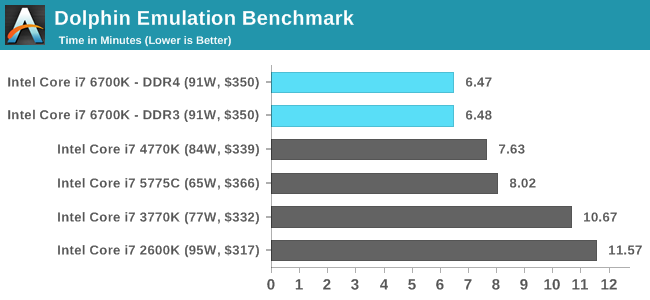
WinRAR 5.0.1: link
Our WinRAR test from 2013 is updated to the latest version of WinRAR at the start of 2014. We compress a set of 2867 files across 320 folders totalling 1.52 GB in size – 95% of these files are small typical website files, and the rest (90% of the size) are small 30 second 720p videos.

3D Particle Movement
3DPM is a self-penned benchmark, taking basic 3D movement algorithms used in Brownian Motion simulations and testing them for speed. High floating point performance, MHz and IPC wins in the single thread version, whereas the multithread version has to handle the threads and loves more cores.
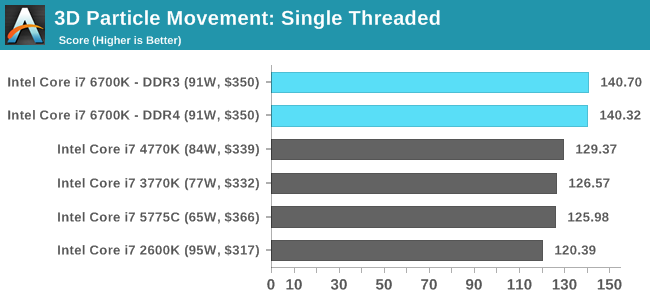
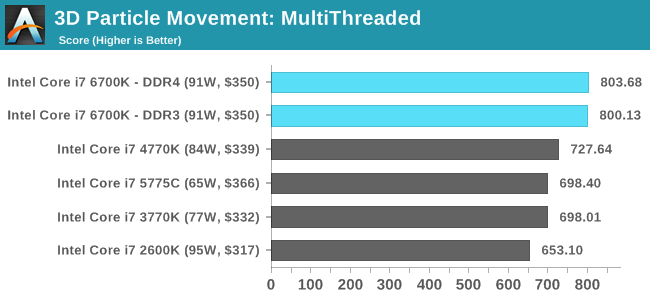
FastStone Image Viewer 4.9
FastStone is the program I use to perform quick or bulk actions on images, such as resizing, adjusting for color and cropping. In our test we take a series of 170 images in various sizes and formats and convert them all into 640x480 .gif files, maintaining the aspect ratio. FastStone does not use multithreading for this test, and results are given in seconds.
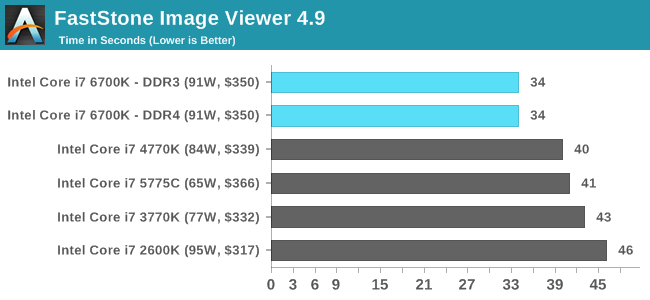
Web Benchmarks
On the lower end processors, general usability is a big factor of experience, especially as we move into the HTML5 era of web browsing. For our web benchmarks, we take four well known tests with Chrome 35 as a consistent browser.
Sunspider 1.0.2
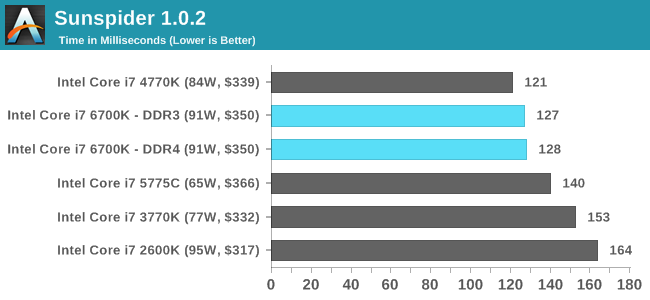
Mozilla Kraken 1.1
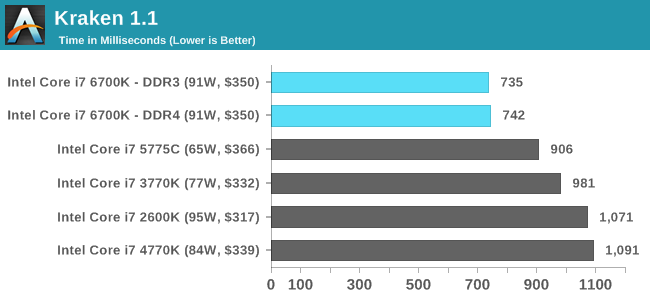
WebXPRT
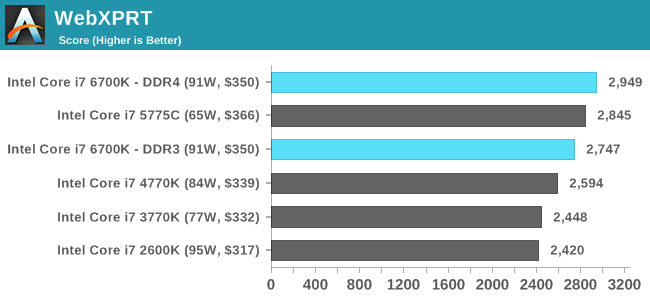
Google Octane v2
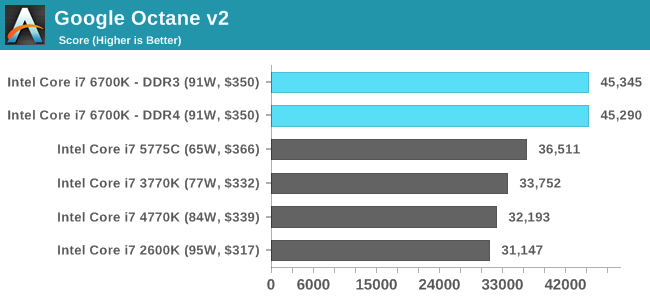










477 Comments
View All Comments
halcyon - Thursday, August 6, 2015 - link
Remember the time, when you could OC 50% or even 100% higher frequency on your CPU?Or the time, when every single c. 1.6 year cycle would bring you at least 50% performance increase?
Those times are over.
I'm still running 4-core(8HT)/tri-channel/SATA3/USB3 platform from 2009.
I see very little reason to upgrade, other than tinkering and spending time.
The money is burning in my hand. Intel is refusing to come out with something that is really worthwhile.
Ah well, maybe Skylake-E or maybe Cannonlake-E, or maybe...
I've been waiting to upgrade for a long time (and have upgraded my GPU several times, as there at least I get some bang for my buck).
Bambooz - Friday, August 7, 2015 - link
I remember my Core 2 Duo E4300 (1.8GHz) that ran at 3.2GHz (400MHz FSB *8) for most of it's life till I replaced it with a Core 2 Quad Q6600 (2.4GHz) that ran at 3.6GHz (400MHz FSB *9). Those were the days when OCing was actually a fun thing to do.. till intel fucked everyone over by making you pay for CPUs that can be OCed or not have any meaningful OC at all.watzupken - Thursday, August 6, 2015 - link
Come to think of it, the comparison of the i7 processor actually put Skylake i7 6700K in an unfavorable position. Honestly, I am more keen to get a Broadwell i7 5775C if I am looking to upgrade. The significantly better graphics, lower TDP and L4 cache seems like a better deal to me. Clockspeed is no big deal since the i7 5775C is overclocking unlocked if I am not mistaken.I think Intel just messed themselves up by launching the desktop variant of Broadwell with Crystal lake graphics just ahead of Skylake.
yhselp - Thursday, August 6, 2015 - link
Thank you for the review. You place a lot of emphasis on gaming and overclocking, value for money, upgrading from SB, and rightly so; however, there are no gaming benchmarks with an overclocked Skylake CPU to illustrate that point -- it would be particularly interesting to see how an i5-6600K@4.5Ghz (assuming it can reach that) fares as that would be most representative of this market.All that Sandy Bridge gamers see now is a 0.9fps to 5.8fps (excluding GRID) improvement which can't possibly justify the price of a new CPU, motherboard and memory.
MiSt77 - Thursday, August 6, 2015 - link
I would like to argue, that it's a little bit too early for the the authors' assertion, that Skylake only gives meagre performance improvements over Broadwell (and earlier processors).Considering that Skylake does in fact feature one big, if not ground breaking, improvement in that (with AVX-512) programmers now have thirty-two¹ 512-bit registers at their disposal, I think Skylake-optimized software should - at least for algorithms amenable to SIMD optimizations - be able to deliver considerable performance improvements.
In this regard it would be interesting to know, if any of the tested software already comes with proper AVX-512 support (or not, as I suppose) - regrettably, there is not even a single mention of this in the benchmark section ...
¹ That is, twice as many as before, which also should help optimizing compilers, as it reduces register pressure.
SuperVeloce - Thursday, August 6, 2015 - link
Um, no. As far as we know, only xeons will get avx-512 enabled.MiSt77 - Thursday, August 6, 2015 - link
Thank you for this factual correction!To my dismay I have to admit that you are right: AVX-512 will only be offered on (some?) Xeon models. As I'm one of those, who where waiting for Skylake specifically because of AVX-512, I find this very disappointing: thanks for ruining my day, Intel.
On the other hand, with the E3-1535M v5 and E3-1505M v5 two (mobile) Xeons were announced recently; maybe my dream of an (AVX-512 enabled) notebook can still become a reality ...
Da W - Thursday, August 6, 2015 - link
Yeee! I'll be able to keep my i7 4770k for at least a decade without upgrading!Time to spend that money on a surface pro 4, a new phone, hololens, whatever else, but my desktop will remain usable!!
Big change from the 90s :)
TheGame21x - Thursday, August 6, 2015 - link
My Core i5 2500k is still chugging along nicely at 4.2 GHz so I think this'll be another generation I'll be skipping. The cost of buying a new motherboard and RAM alongside the new CPU is a bit more than I'm willing to spend as of now given the performance increase.sweeper765 - Thursday, August 6, 2015 - link
Another Sandy Bridge owner here (2500k @ 4.6GHz 1.27v load).I've been waiting for a worthwhile upgrade. This is close but i'm not yet convinced.
The ipc improvements and new instructions are attractive but there are some negative points too:
- hotter, always hotter. Why no temperature analysis ? I see from other reviews temps in the high 80's with water cooling setups. Is this was passes as normal these days?
- need to buy DDR4 besides cpu and motherboard. I see there is a strong push towards this, despite having no real benefit relative to DDR3 (same bandwidth at the same frequency). Basically it's a kind of high frequency DDR3L. Please don't say it saves power, it's only a few watts less than ddr3 at best.
- why is stock voltage so high for 14nm technology? It's higher than my oc voltage on a 32nm 4 years old cpu. Power consumption in load is also pretty high.
- i was hoping for avx3
- cannot install win7 from usb are you kidding me? I don't have an optical drive and was doing fine without it for years now
- price goes up from generation to generation. 2600k launched at 317$, 6700k at 350$
- connectivity wise i would have liked to see more usb on back panel and more internal sata , especially with sata express consuming 2 standard ports.